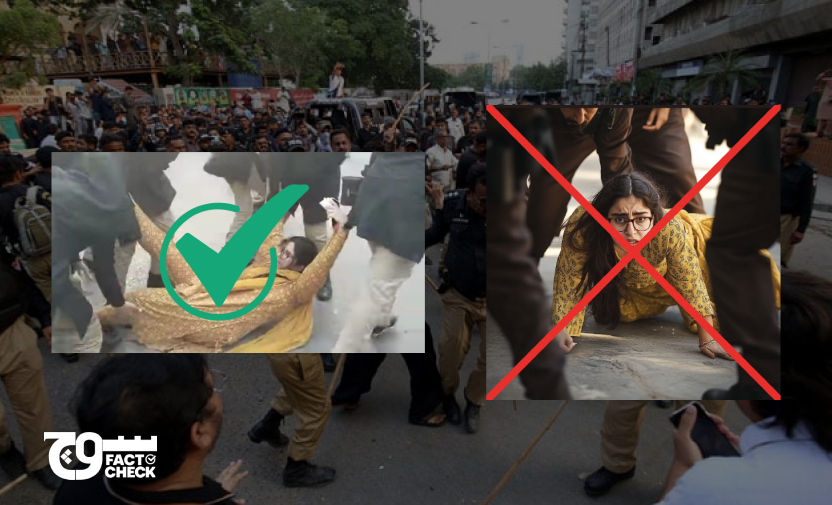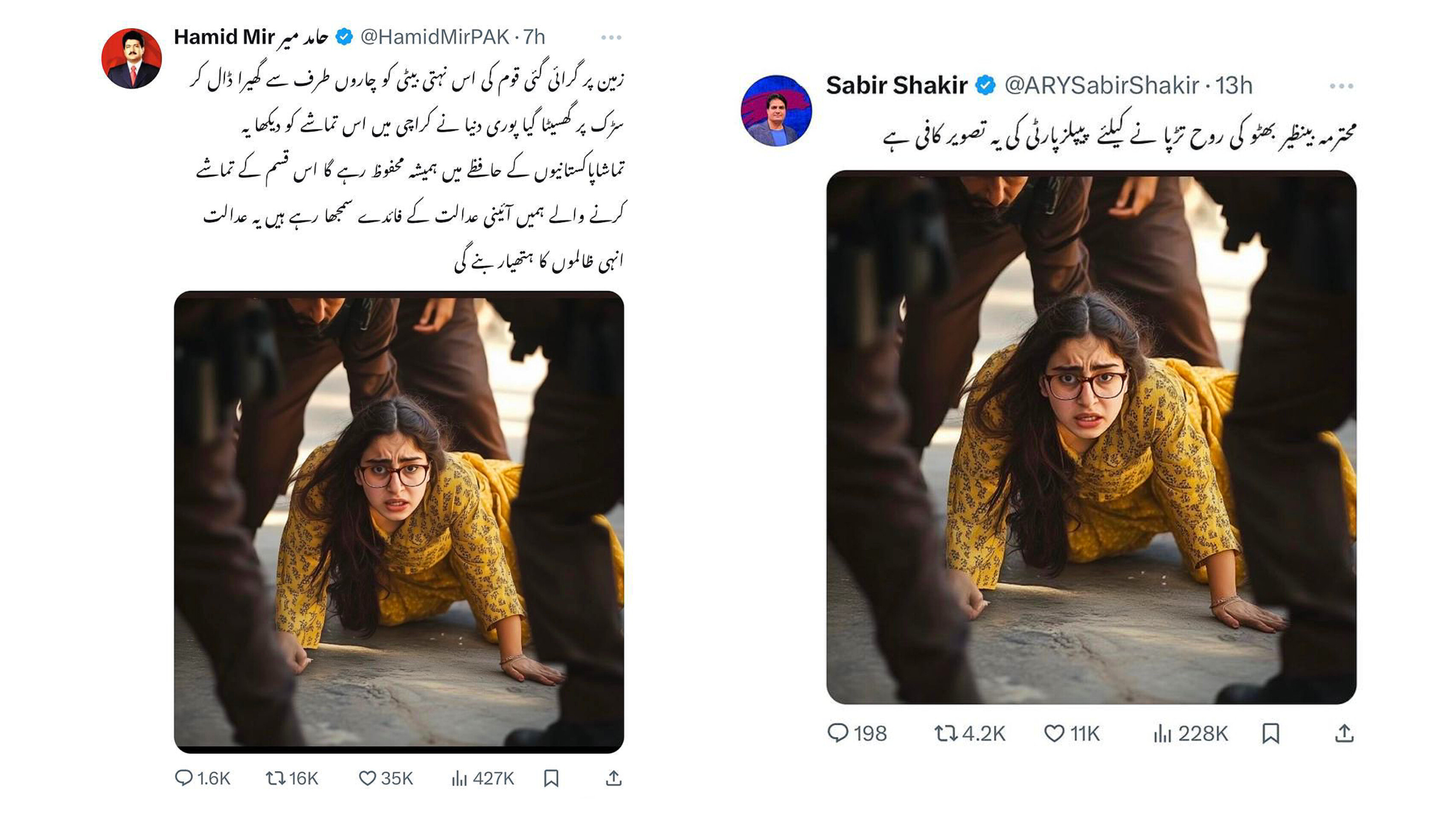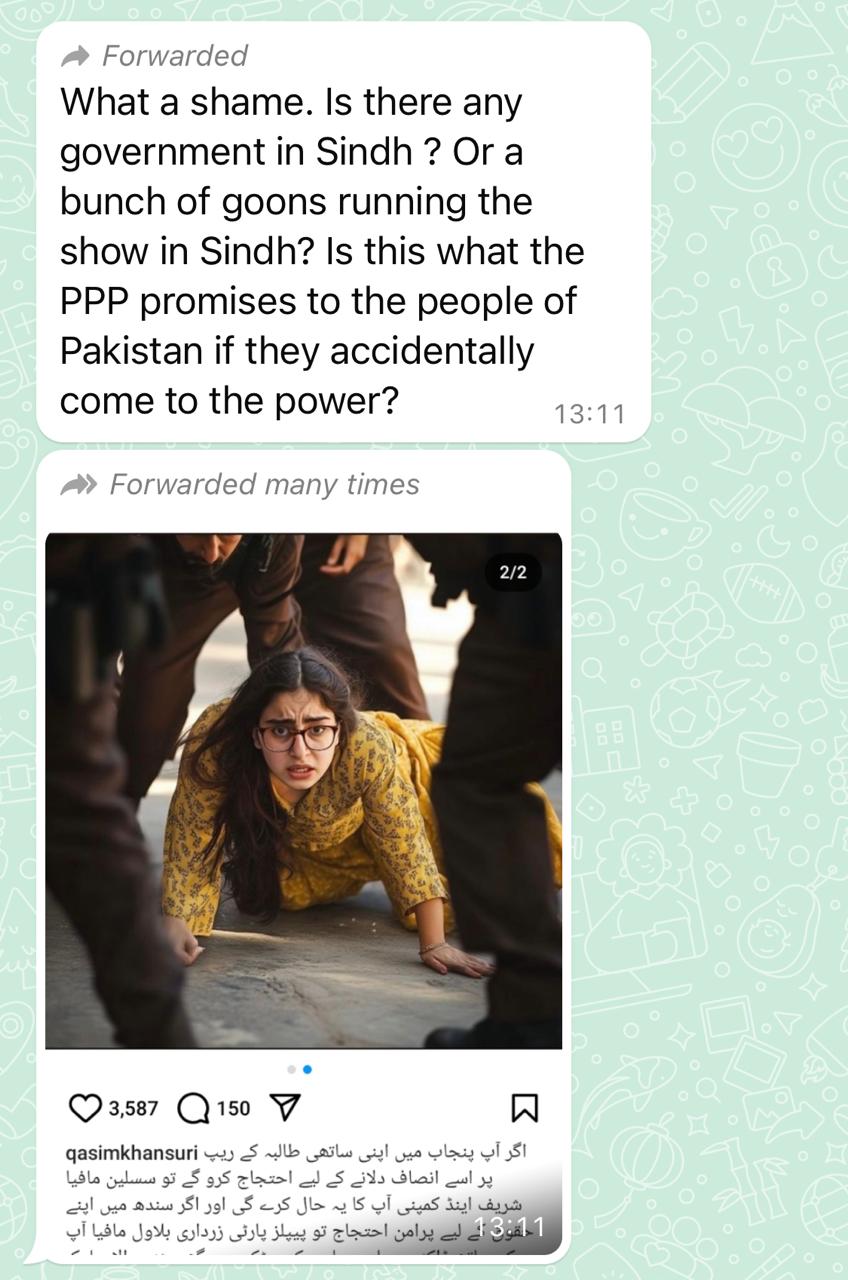
Disclaimer: While the fact that the Sindh Police manhandled women during the Sindh Rawadari March outside the Karachi Press Club on 13 October is not disputed, this fact-check focuses solely on analysing the viral image.
Claim: An image shows demonstrator Romasa Jami manhandled by the police at the Sindh Rawadari March that was held in Karachi on 13 October.
Fact: We analysed the image using AI detection tools, such as Hive Moderation and Sight Engine and found that it was AI-generated.
On 13 October, X user @ErumJavaid shared an image (archive) of a woman, writing, “ایک وقت تھا کہا جاتا تھا ہم مائیں ہم بہنیں ہم بیٹیاں قوموں کی عزت ہم سے ہے
آج کے پاکستان میں ہم ماؤں بہنوں بیٹیوں کو پاکستان کی سڑکوں پر گھسیٹا جاتا ہے سروں سے چادریں چھین لی جاتی ہیں”
[Translated from Urdu: It was once said that we are mothers, we are sisters, we are daughters, the honor of nations is with us
In today’s Pakistan, we, the mothers, sisters and daughters, are dragged on the streets of Pakistan and the sheets are taken from our heads.]
The image later circulated widely on social media platforms. Journalists Sabir Shakir and Hamid Mir also shared it on X, with their respective posts available here (archive) and here.

It also circulated widely on WhatsApp.

Sindh Rawadari March
The Sindh Rawadari March held on 13 October brought together progressive voices from across the province, including human rights defenders, trade unions, and feminist movements, to protest the extrajudicial killing of Dr Shah Nawaz Kunbhar.The march, held outside the Karachi Press Club, aimed to condemn his killing, which occurred during a “staged encounter” by the police in Mirpurkhas on 19 September.
In response to the SRM, the Tehreek-e-Labbaik Pakistan also decided to hold a demonstration. To prevent any potential clashes, the government imposed Section 144, The News reported. However, both groups defied the ban, leading to police intervention and clashes, the same report added. The violence resulted in the death of an alleged TTP worker, injuries to several individuals, including police officers, and the arrest of around 70 people. Amid the chaos, a police vehicle was also set on fire.
Footage showing police performing baton charges on demonstrators outside the Karachi Press Club was shared widely within the media. Geo News reporter Waqas Aalam shared videos on X, writing, “Today, I was assigned to cover Sindh Rawadari March in Karachi. When protesters arrived at KPC, Police unleashed brutal violence on them, dragged women on the road. They did baton charge on journalists, too. (I was hit with one myself). People were agitating for peace in Sindh.”
Fact or Fiction?
To investigate whether the viral image is authentic, we reviewed footage captured by Soch Video’s team, who were present at the Karachi Press Club to cover the Sindh Rawadari March. In the video, protester Romasa Jami is seen being shoved and eventually carried away by female police officers. Similar footage has been shared here and here on X.
In the viral image, Jami is shown on her hands and feet, but footage from the protest reveals that she was actually lying on her back. Additionally, she is surrounded by female police officers, whereas in the image, a male officer is visible in the top left corner, bending forward.
There is a significant discrepancy in the Sindh Police uniform colour: the official uniform includes beige-coloured pants, which is evident in the footage, while the officers in the image are wearing brown pants. Moreover, the posture of the male officer in the background and his limbs appear unusual.
Upon closer inspection, several anomalies are noticeable on the woman’s body. Her left wrist is extended awkwardly, and her right hand appears strangely attached to her shirt sleeve. Her legs are bent unnaturally, with her feet hidden from view. AI images are often not able to replicate human hands and feet realistically. Notably, her clothes in the image in question do not match what she is wearing in the actual footage: in the image, the print on her shirt appears blue at the top but fades to white toward the bottom of her shirt and trousers when she was actually in a yellow-printed kameez and shalwar. In the footage, Jami is clearly seen wearing a dupatta, which is missing entirely in the viral image.
We also ran the image through Hive Moderation, an AI-powered content moderation tool used to automatically review and filter user-generated content on online platforms. It flagged the content as highly likely to be AI-generated or a deepfake, with a 98% probability. The analysis broke down the result into specific classifications: “AI-generated” received a score of 0.98, “Midjourney” 0.89, and “Stable Diffusion” 0.06. In contrast, “None” and “Not AI-generated” were rated significantly lower, at 0.03 and 0.01, respectively. These percentages are part of Hive’s rating system and typically reflect probabilities out of 1.0 (or 100%), representing the model’s confidence in each category. The figures indicate a strong likelihood that the image was produced using AI tools.
We also analysed the image using Sight Engine, a content moderation and image analysis tool that detects AI-generated media. According to the results, there was a 99% likelihood that the viral image was AI-generated. Specifically, the “GenAI” classification received a score of 99%, and “MidJourney” was rated at 95%. This suggests that the image is predominantly linked to AI generation, particularly through MidJourney, which is a popular AI-based image generation tool that allows users to create artwork from text prompts.
A team member from Soch Videos who was present at the scene mentioned that, due to the significant commotion, it would have been impossible for anyone to capture an image from such a low angle.
Lawyer and executive director of the Digital Rights Foundation, Nighat Dad, also took to X to highlight that the image is AI-generated. She reposted the viral image, saying, “This is an AI-generated image which was made without the consent of this protestor please stop circulating this – however, the actual situation against protestor was far worse than this. #Deepfake”
We reached out to Romasa Jami, who expressed surprise at seeing notable personalities share the image, stating that it was clearly fake: “It was very obvious — they should have understood that it was AI-generated.”
Jami also noted that AI-generated images can mislead viewers into doubting whether events actually occurred, adding, “Such images should not be created, I am not in favour of that.”
Virality
The image went viral on WhatsApp across Pakistan, as indicated by the ‘forwarded many times’ label attached to the message we received.
The image was shared here, here, here, here, here, and here on X. Archived here, here, here, here, here, and here.
On Facebook, it was shared here, here, here, here, here, and here.
It was also shared here, here, and here on Threads.
Conclusion: While Soch Fact Check does not dispute that female protesters were manhandled by Sindh Police at the Sindh Rawadari March, a viral image claiming to depict a protestor who was manhandled at the Sindh Rawadari March is AI-generated.
–
Background image in cover photo: The News
To appeal against our fact-check, please send an email to appeals@sochfactcheck.com
